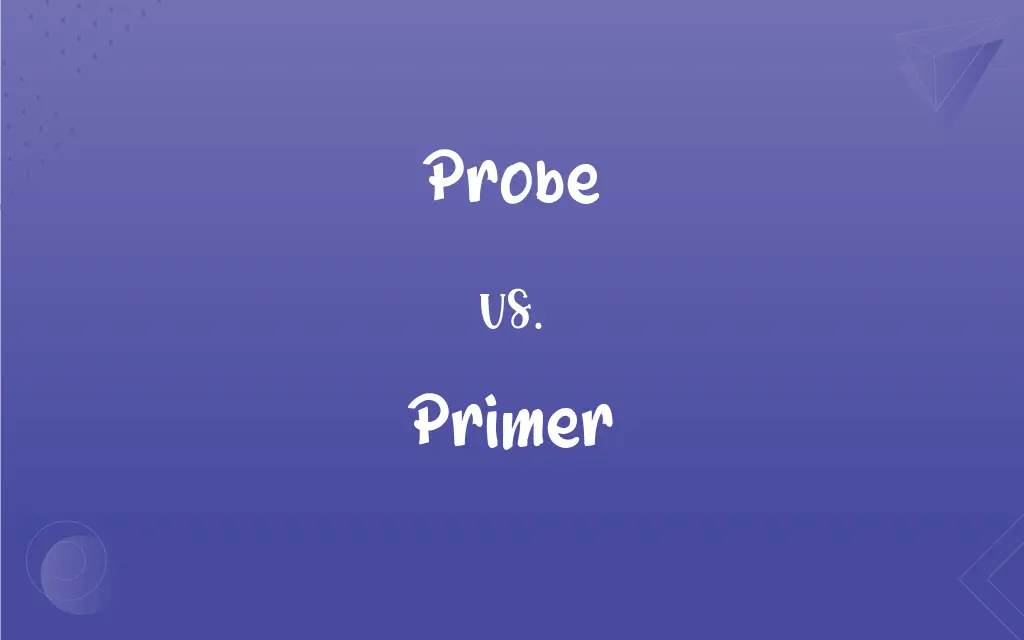Probe vs. Primer: What's the Difference?
Edited by Aimie Carlson || By Janet White || Published on February 16, 2024
Probe is a short strand of DNA or RNA used to detect the presence of complementary sequences. Primer is a short sequence of DNA that provides a starting point for DNA synthesis.

Key Differences
A probe in molecular biology is a fragment of DNA or RNA used to detect the presence of complementary sequences in a sample by hybridization. In contrast, a primer is a short single-stranded DNA sequence used in PCR and DNA sequencing to initiate DNA synthesis.
Probes are designed to be complementary to a specific DNA or RNA sequence in a target molecule, allowing them to bind specifically for detection purposes. Primers, however, are used to start the replication process in PCR, binding to a specific starting point on the DNA template.
In use, probes are often labeled with fluorescent or radioactive markers to visualize the hybridization with the target sequence. Primers, on the other hand, are not labeled but are crucial for guiding DNA polymerases to the correct initiation site for replication.
Probes are essential in techniques like fluorescent in situ hybridization (FISH) for locating specific DNA sequences on chromosomes. Primers are indispensable in PCR for amplifying specific DNA fragments for further analysis.
Probes are used for detection and localization of specific sequences, while primers are used for amplifying these sequences. This distinction underlines their different but complementary roles in molecular biology.
ADVERTISEMENT
Comparison Chart
Primary Function
Detecting specific DNA or RNA sequences
Initiating DNA synthesis in PCR
Design
Complementary to target DNA/RNA sequences
Complementary to the start of a DNA segment
Labeling
Often labeled with fluorescent or radioactive markers
Not labeled, used for replication initiation
Usage
In situ hybridization, gene expression studies
PCR, DNA sequencing
Role
Detection and localization
Amplification
ADVERTISEMENT
Probe and Primer Definitions
Probe
Identifies specific DNA or RNA sequences.
The probe successfully hybridized to its target gene in the sample.
Primer
A brief sequence used in PCR and sequencing.
We designed a primer specific to the gene of interest.
Probe
Often tagged with a marker for visibility.
We used a fluorescently labeled probe for the FISH experiment.
Primer
Provides a starting point for DNA replication.
The primer annealed to the template strand, initiating PCR.
Probe
Used in studying gene expression patterns.
Probes help identify which genes are active in cancer cells.
Primer
Used in DNA sequencing to mark starting points.
Primers are crucial for determining the sequence of DNA fragments.
Probe
Binds to complementary sequences for detection.
The probe's binding indicated the presence of the viral RNA.
Primer
Directs DNA polymerase to the correct replication site.
The primer guides the polymerase to the DNA replication start site.
Probe
Essential in diagnostic tests for specific sequences.
A specific probe was used to detect the pathogen's DNA.
Primer
Essential for the polymerase chain reaction process.
Without the primer, the PCR process cannot begin.
Probe
A slender, flexible surgical instrument used to explore a wound or body cavity.
Primer
An elementary textbook for teaching children to read.
Probe
An electrode or other device that can be placed inside something to take and convey measurements.
Primer
A book that covers the basic elements of a subject.
Probe
A substance, such as DNA, that is radioactively labeled or otherwise marked and used to detect or identify another substance in a sample.
FAQs
What does a primer do in PCR?
Initiates the DNA synthesis process.
How are probes labeled?
With fluorescent or radioactive markers.
Can primers be used for DNA detection?
Primers are mainly for amplification, not detection.
Can probes be reused?
In some applications, yes, but usually they are single-use.
Can primers bind anywhere on DNA?
They are designed to bind to specific start sites.
Is a probe used for quantification?
It can be, particularly in quantitative PCR (qPCR).
How specific are primers?
Highly specific to the target DNA sequence.
Are primers labeled?
No, primers are not labeled.
How long are primers?
Generally 18-22 nucleotides long.
Do primers require specific temperatures?
Yes, their annealing temperature is critical in PCR.
What is a DNA probe used for?
Detecting specific DNA or RNA sequences.
Are probes used in PCR?
Not typically; they are used more for detection and localization.
What's the length of a typical probe?
Usually 20-30 nucleotides long.
What is FISH in the context of probes?
Fluorescent in situ hybridization, a technique using fluorescent probes.
How do primers affect PCR efficiency?
Their design and annealing temperature can greatly influence PCR success.
What happens if a primer is not properly designed?
It can lead to nonspecific binding or failed amplification in PCR.
Can probes be used for RNA detection?
Yes, they can detect specific RNA sequences.
How do probes identify genes?
By binding to complementary sequences in the gene.
What is the main role of a primer in sequencing?
To mark the starting point for DNA synthesis.
Are probes necessary for all DNA studies?
Not for all, but essential for specific sequence detection.
About Author
Written by
Janet WhiteJanet White has been an esteemed writer and blogger for Difference Wiki. Holding a Master's degree in Science and Medical Journalism from the prestigious Boston University, she has consistently demonstrated her expertise and passion for her field. When she's not immersed in her work, Janet relishes her time exercising, delving into a good book, and cherishing moments with friends and family.
Edited by
Aimie CarlsonAimie Carlson, holding a master's degree in English literature, is a fervent English language enthusiast. She lends her writing talents to Difference Wiki, a prominent website that specializes in comparisons, offering readers insightful analyses that both captivate and inform.







































































